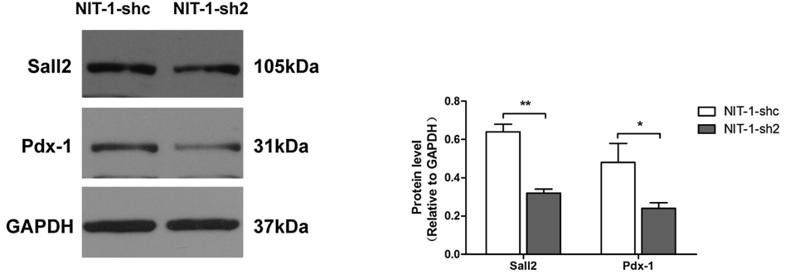PDX1 Antibody - #DF7170
| Product: | PDX1 Antibody |
| Catalog: | DF7170 |
| Description: | Rabbit polyclonal antibody to PDX1 |
| Application: | WB IHC |
| Cited expt.: | WB |
| Reactivity: | Human, Mouse, Rat |
| Prediction: | Pig, Bovine, Horse, Sheep, Rabbit, Dog, Chicken, Xenopus |
| Mol.Wt.: | 31kDa; 31kD(Calculated). |
| Uniprot: | P52945 |
| RRID: | AB_2839122 |
Related Downloads
Protocols
Product Info
*The optimal dilutions should be determined by the end user. For optimal experimental results, antibody reuse is not recommended.
*Tips:
WB: For western blot detection of denatured protein samples. IHC: For immunohistochemical detection of paraffin sections (IHC-p) or frozen sections (IHC-f) of tissue samples. IF/ICC: For immunofluorescence detection of cell samples. ELISA(peptide): For ELISA detection of antigenic peptide.
Cite Format: Affinity Biosciences Cat# DF7170, RRID:AB_2839122.
Fold/Unfold
Glucose sensitive factor; Glucose-sensitive factor; GSF; IDX 1; IDX-1; IDX1; Insulin promoter factor 1; Insulin promoter factor 1 homeodomain transcription factor; Insulin upstream factor 1; IPF 1; IPF-1; IPF1; Islet/duodenum homeobox 1; Islet/duodenum homeobox-1; IUF 1; IUF-1; IUF1; MODY4; Pancreas/duodenum homeobox 1; Pancreas/duodenum homeobox protein 1; pancreatic and duodenal homeobox P; PDX 1; PDX-1; PDX1; PDX1_HUMAN; Somatostatin transactivating factor 1; Somatostatin-transactivating factor 1; STF 1; STF-1; STF1;
Immunogens
A synthesized peptide derived from human PDX1, corresponding to a region within the internal amino acids.
Duodenum and pancreas (Langerhans islet beta cells and small subsets of endocrine non-beta-cells, at low levels in acinar cells).
- P52945 PDX1_HUMAN:
- Protein BLAST With
- NCBI/
- ExPASy/
- Uniprot
MNGEEQYYAATQLYKDPCAFQRGPAPEFSASPPACLYMGRQPPPPPPHPFPGALGALEQGSPPDISPYEVPPLADDPAVAHLHHHLPAQLALPHPPAGPFPEGAEPGVLEEPNRVQLPFPWMKSTKAHAWKGQWAGGAYAAEPEENKRTRTAYTRAQLLELEKEFLFNKYISRPRRVELAVMLNLTERHIKIWFQNRRMKWKKEEDKKRGGGTAVGGGGVAEPEQDCAVTSGEELLALPPPPPPGGAVPPAAPVAAREGRLPPGLSASPQPSSVAPRRPQEPR
Predictions
Score>80(red) has high confidence and is suggested to be used for WB detection. *The prediction model is mainly based on the alignment of immunogen sequences, the results are for reference only, not as the basis of quality assurance.
High(score>80) Medium(80>score>50) Low(score<50) No confidence
Research Backgrounds
Activates insulin, somatostatin, glucokinase, islet amyloid polypeptide and glucose transporter type 2 gene transcription. Particularly involved in glucose-dependent regulation of insulin gene transcription. As part of a PDX1:PBX1b:MEIS2b complex in pancreatic acinar cells is involved in the transcriptional activation of the ELA1 enhancer; the complex binds to the enhancer B element and cooperates with the transcription factor 1 complex (PTF1) bound to the enhancer A element. Binds preferentially the DNA motif 5'-[CT]TAAT[TG]-3'. During development, specifies the early pancreatic epithelium, permitting its proliferation, branching and subsequent differentiation. At adult stage, required for maintaining the hormone-producing phenotype of the beta-cell.
Phosphorylated by the SAPK2 pathway at high intracellular glucose concentration. Phosphorylated by HIPK2 on Ser-268 upon glucose accumulation. This phosphorylation mediates subnuclear localization shifting. Phosphorylation by PASK may lead to translocation into the cytosol (By similarity).
Nucleus. Cytoplasm>Cytosol.
Duodenum and pancreas (Langerhans islet beta cells and small subsets of endocrine non-beta-cells, at low levels in acinar cells).
The Antp-type hexapeptide mediates heterodimerization with PBX on a regulatory element of the somatostatin promoter.
The homeodomain, which contains the nuclear localization signal, not only mediates DNA-binding, but also acts as a protein-protein interaction domain for TCF3(E47), NEUROD1 and HMG-I(Y).
Belongs to the Antp homeobox family. IPF1/XlHbox-8 subfamily.
Research Fields
· Human Diseases > Endocrine and metabolic diseases > Type II diabetes mellitus.
· Human Diseases > Endocrine and metabolic diseases > Maturity onset diabetes of the young.
· Organismal Systems > Endocrine system > Insulin secretion. (View pathway)
References
Application: WB Species: mouse Sample: NIT-1-shc and NIT-1-sh2 cells
Application: WB Species: rat Sample: islets
Restrictive clause
Affinity Biosciences tests all products strictly. Citations are provided as a resource for additional applications that have not been validated by Affinity Biosciences. Please choose the appropriate format for each application and consult Materials and Methods sections for additional details about the use of any product in these publications.
For Research Use Only.
Not for use in diagnostic or therapeutic procedures. Not for resale. Not for distribution without written consent. Affinity Biosciences will not be held responsible for patent infringement or other violations that may occur with the use of our products. Affinity Biosciences, Affinity Biosciences Logo and all other trademarks are the property of Affinity Biosciences LTD.





